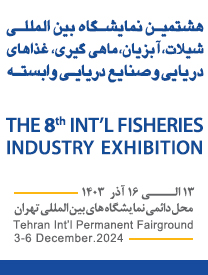




History of Fisheries Industry
Fisheries is the science of sustainable and economic exploitation of water resources, which is active in the world in two fields of aquaculture and fishing. The fishing industry in our country is relatively young compared to the developments in the world's fishing industry in the last 50 years. In this field, students get to know the different sciences of animal and plant biology and marine ecology as the infrastructure of fisheries and they study about the inland and marine aquatics, how to reproduce and breed aquatics, how to catch and also fishing and how to process marine products. The importance of this field becomes clearer and more obvious when we know the correct and sustainable exploitation of marine resources, protection of resources and restoration of reserves, diversification in production and increase in production, improvement and promotion of the quality of fishery products from production to consumption, the use of new technologies of genetic engineering in fisheries, employment and foreign exchange income are not possible without a scientific attitude and relying on research findings in fisheries.
Fisheries is a set of sciences that studies the identify, ecology, how to catch and also fishing, catching and exploiting, maintaining, handling and processing fish and other aquatic animals or their products. The word shale is derived from the name of a fishing river. Among the most important areas of expertise that are collectively called fisheries and industries sciences, the following can be mentioned:
Ichthyology
Reproduction and breeding of fish, shrimp, oysters, mollusks and marine plants
Limnology or ecology of freshwater
Ecology of seas
Catching and exploitation of industrial fishing
Processing of fishery products
Feeding farmed aquatics
Currently, in Iran, the field of fisheries engineering is being taught at the bachelor's level in the following four majors:
1. Aquatic Reproduction and Breeding
2. Aquatic Ecology
3. Processing of fishery products
4. Aquatic Fishing
Aquatic farming (fish and shrimp), fishing in northern and southern waters of the country, processing marine products and distributing and selling them in domestic and international markets constitute a set of profitable economic activities that creates employment for various Manpower skills and also brings good foreign exchange income to the country's economy.
History of Fisheries Industry
The root of the word "fishery" comes from the word "shale". Shail was a fishing tool that was used to catch white fish in the north of the country, and its plural form is Shilat.
Exploitation of the southern shores of the Khazar Sea in the form of annual rent began in 1219 SH (the reign of Muhammad Shah Qajar). This legal system has been in operation for 80 years until 1299 SH. Until the time of Muhammad Shah, the rulers of each region leased rivers and seas to Russian citizens at will but since 1215 SH, this authority was canceled by the order of Muhammad Shah.
In 1306 SH, an agreement was signed between the governments of Iran and the former Soviet Union to establish a joint venture for fishing on the southern shores of the Mazandaran Sea, and other inland rivers were under the control of the Ministry of Finance, which were leased annually through an auction.
In 1332 SH, Shilat company was declared national by Dr. Mohammad Mossadegh, former prime minister at the time, and was named Shilat Iran. These formations were the first official organizational structure of fishing in the country that is why it is was called Iran's fisheries.
Until the year of 1332 SH (the announcement of nationalization of fisheries), fisheries activities were carried out based on the contracts of Iran and Russia, and the northern rivers were also under the control of the Ministry of Finance and were handed over through auctions.
With the establishment of the Ministry of Natural Resources in January 1346, Iran's Fisheries became affiliated to this Ministry and after the dissolution of the aforementioned Ministry, the fisheries affairs were added to the duties of the Ministry of Agriculture.
The first regulation of fishing in the Caspian Sea was compiled and implemented in the year of 1332 after the nationalization of the Iran Fisheries Company, which mainly included determining the permitted and prohibited fishing seasons and determining the authorized fishing areas.
The first governmental activity in the field of aquatics was carried out with the cooperation of the Danish professor Belgwad in 1316 SH on southern fishes. In 1328, this work was continued by Danish Dr. Petresen.
During the years 1334 to 1335 Hijri Shamsi, a Japanese company conducted studies regarding the development of fishing in the south, regarding all types of aquatic life in the Persian Gulf, especially fish and shrimp, and as a result, it was found that it is possible to exploit the water resources of the Persian Gulf throughout the year. In 1335, the Planning and Budget Organization of the Persian Gulf Fishing Company was established with the participation of the Japanese under the name "Persian Gulf Fishing", in which Japan was a shareholder of, and then in 1336, all the shares of this company were transferred to the planning organization.
In the year of 1340 in Shahrivar, in the implementation of Iran's fisheries law and the request of the Ministry of Finance and the approval of the planning organization and the approval of the government, this company was transferred to Shilat and finally led to the formation of the South Fisheries Joint Stock Company was done in 1342 with the shareholding of the Ministry of Finance, the Ministry of War, Red Lion and Sun Society and Agriculture Cooperative Bank
The South Fisheries Joint Stock Company was established with the participation of a number of government ministries and organizations and by creating a fishing fleet and several piers and fishing processing complexes, it took action to expand fishing activities.
In 1343, the first fishing regulations regarding fishing activities in the south of the country (Persian Gulf, Oman Sea and subordinate rivers) including seasonal, spatial and tool restrictions were compiled.
For the first time in 1301, the production and release of 3 million pieces of baby fish for release in the sea of Mazandaran was done.
During the years 1347 to 1350, in order to preserve the valuable stock of sturgeon fish and breeding and reproduction of carp fish, Sangsar Dam Fish reproduction and Breeding Workshop and Astana Bridge reproduction and Breeding Station were established.
After the Islamic revolution, with the merger of the North and South companies and the establishment of the Iran Fisheries Joint Stock Company under the Ministry of Agriculture, the government's supervision and activity expanded to all aspects of the country's fisheries, including inland waters and aquatic reproduction and breeding.
In 1361, based on the resolution of the Revolutionary Council, the North and South Fisheries Companies merged in the Deputy Ministry of Fisheries and Aquatics Affairs of the Ministry of Agriculture were established under the name Shilat Iran Joint Stock Company.
In the year of 1366, in Shahrivar, with the proposal of the heads of the three powers and the approval of the great leader of the Islamic Revolution, Ayatollah Imam Khomeini, the Iranian Fisheries Joint Stock Company was taken from the Ministry of Agriculture and annexed to the Ministry of Agriculture Jihad.
Iranian Fisheries Research Organization was established in the year of 1369.
The law on the protection and exploitation of water resources of the Islamic Republic of Iran was approved by the Islamic Council on 14/06/1374 and was approved by the Guardian Council on 22/06/1374.
The executive regulations of the Islamic Republic of Iran's water resources protection and exploitation law were also approved by the Council of Ministers on 25/02/1378.
On May 14th, 1993, Dr. Dadman's International Sturgeon Research Institute was opened by Mr. Hashemi Rafsanjani.
In 1374, the name of Iran Fisheries Research and Training Organization was changed to Iran Fisheries Research Institute.
The formation of the Ministry of Agricultural Jihad from the merger of the two ministries of Agriculture and Jihad of Construction in 1379 and the placement of Iranian Fisheries in the new ministry.
In 1381, the Fisheries Research Institute was extracted from the Iran Fisheries Joint Stock Company and joined to the Agricultural Research and Training Organization.
The statute of Iran Fisheries Research Institute was approved by the Higher Education Council on 02/20/2003.
88070693 (021)98+
88085340 (021)
88070693 (021)
no.908, Alvand Tower, Ebrahimi St, Marzdaran Blvd, Tehran, Iran



